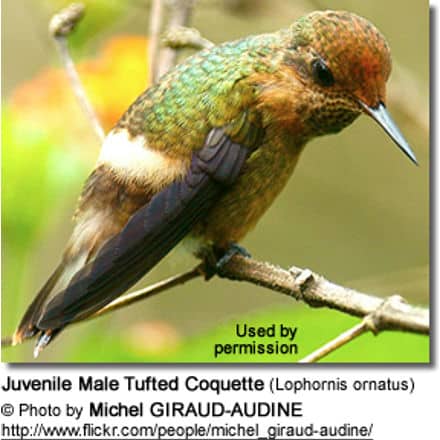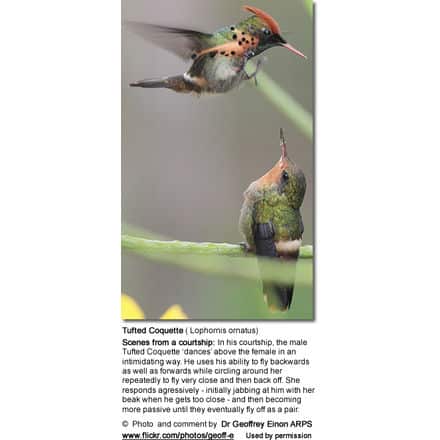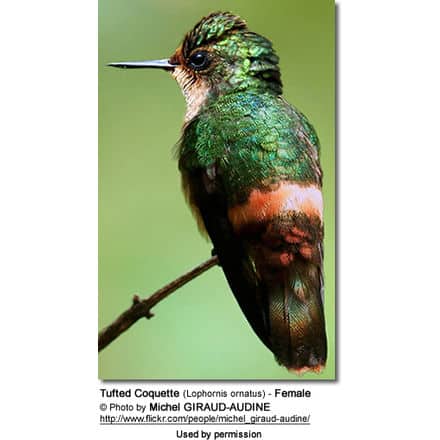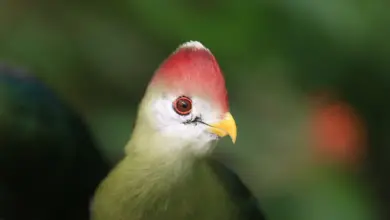Tufted Coquette (Lophornis ornatus)
The Tufted Coquettes (Lophornis ornatus) – also known as Splendid Coquette – is a South American hummingbird.
Distribution / Range
The Tufted Coquette is uncommon within its wide range. They are mostly found alone or in small groups, as they search for nectar and small insects to feed on.
The Tufted Coquette breeds in eastern Venezuela, Trinidad, Suriname, the Guianas, and south to northern Brazil. It appears to be a local or seasonal migrant; however, little is known about its movements at this point in time.
Countries they occur in …
Brazil; French Guiana; Guyana; Suriname; Trinidad and Tobago; Venezuela
Habitat:
They are found in open country, at the edges of humid forests, and thickets, as well as in cultivated areas like gardens, plantations and savannas.
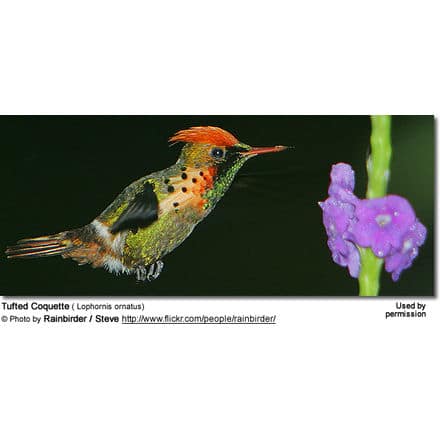
Description
The Tufted Coquette is a very small hummingbird – only averaging 6.6 – 8 cm (2.6 – 3.1 inches) in length – including its tail and weighing around 2.3 g (0.08 ounces). It is so tiny that it can easily be confused with a large bee as it moves from flower to flower. Its red beak has a black tip and is short and straight..
The male has striking black-spotted rufous / orangey-colored feathers that project from the sides of his neck and a rufous / orangey head crest. His back is coppery green with a whitish rump band. His forehead and underplumage are green and the tail is a golden rufous.
The female doesn’t have the flashy crest and plumes of the male. She is green above, except for the whitish tail band. Her underplumage is rufous-colored, becoming much paler on the abdomen. Her tail is bronze green with a dusky band and whitish feather tips.
Juvenile males look like females, but the throat is whitish with fine dark spotting; they have a white rump, reddish forehead, and close to maturity, juvenile males show a hint of the future streamers on the neck. (Description of juvenile male provided by photographer Michel Giraud-Audine.)
Personality: Tufted Coquettes tend to be quite approachable
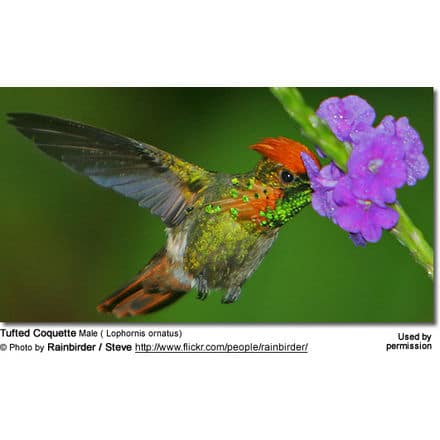
Nesting / Breeding
Hummingbirds in general are solitary and neither live nor migrate in flocks; and there is no pair bond for this species – the male’s only involvement in the reproductive process is the actual mating with the female.
Males court females by flying in a U-shaped pattern in front of them. Their courtship behavior is well demonstrated by Dr. Einon’s images and comments to the right and below.
The male will separate from the female immediately after copulation. He does not participate in choosing the nest location, building the nest, or raising the chicks
The female Tufted Coquette alone is responsible for building the cup-shaped nest out of plant fibers woven together and green moss on the outside for camouflage in a protected location in a shrub, bush, or tree. She lines the nest with soft plant fibers, animal hair, and feathers down, and strengthens the structure with spider webbing and other sticky material, giving it an elastic quality to allow it to stretch to double its size as the chicks grow and need more room. The nest is typically found on a low, skinny horizontal perch.
The average clutch consists of one to three white eggs (usually two), which she incubates alone for 13 to 14 days, while the male defends his territory and the flowers he feeds on. The young are born blind, immobile, and without any down.
The female alone protects and feeds the chicks with regurgitated food (mostly partially digested insects since nectar is an insufficient source of protein for the growing chicks). The female pushes the food down the chicks’ throats with her long bill directly into their stomachs.
As is the case with other hummingbird species, the chicks are brooded only the first week or two and are left alone even on cooler nights after about 12 days – probably due to the small nest size. The chicks leave the nest when they are about 19 to 20 days old.

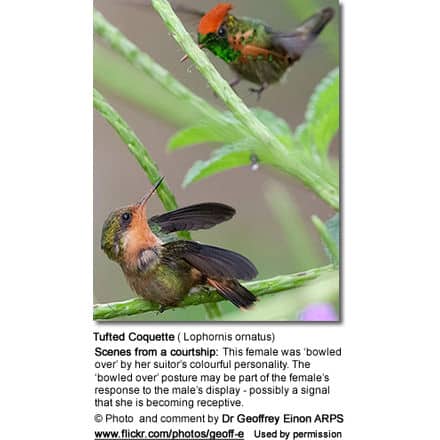
Diet / Feeding
The Tufted Coquettes primarily feed on nectar taken from a variety of brightly colored, scented small flowers of trees, herbs, shrubs and epiphytes. They favor flowers with the highest sugar content (often red-colored and tubular-shaped) and seek out, and aggressively protect, those areas containing flowers with high energy nectar.
They use their long, extendible, straw-like tongues to retrieve the nectar while hovering with their tails cocked upward as they are licking at the nectar up to 13 times per second. Sometimes they may be seen hanging on the flower while feeding.

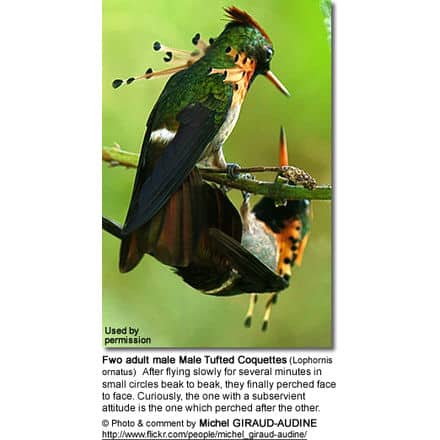
Calls / Vocalizations
Tufted Coquettes are usually silent, but may give a quiet chik while feeding.
Alternate (Global) Names:
Spanish: Coqueta Adornada or Coqueta Abanico Canela … Portugese (Brazil): Tufinho-vermelho … French: Coquette huppe-col … German: Schmuckelfe … Dutch: Gekuifde Koketkolibrie … Chinese: ???? … Czech: Kolibrík ozdobný, kolib?ík ozdobný … Danish: Guyanapragtalf … German: SchmuckelfeFinnish: Liinasolmiokolibri … French: Coquette huppe-col, Huppe-col orné … Italian: Colibrì coquette ornato, Coquette dai ciuffetti … Japanese: hookazarihachidori … Dutch: Gekuifde Koketkolibrie … Norwegian: Ornatkokette … Polish: sylfik strojny … Portuguese: Beija-flor-de-leque-canela, topetinho-de-leque-canela, tufinho-vermelho … Russian: ?????????? ??????? … Slovak: goliercik ozdobný … Spanish: Coqueta Abanico Canela, Coqueta Adornada … Swedish: Tofskokott
Amazing images of a male Tufted Coquette taken by Michel Giraud-Audine
Hummingbird Resources
- Hummingbird Information
- Hummingbird Amazing Facts
- Attracting Hummingbirds to Your Garden
- Hummingbird Species
- Feeding Hummingbirds

